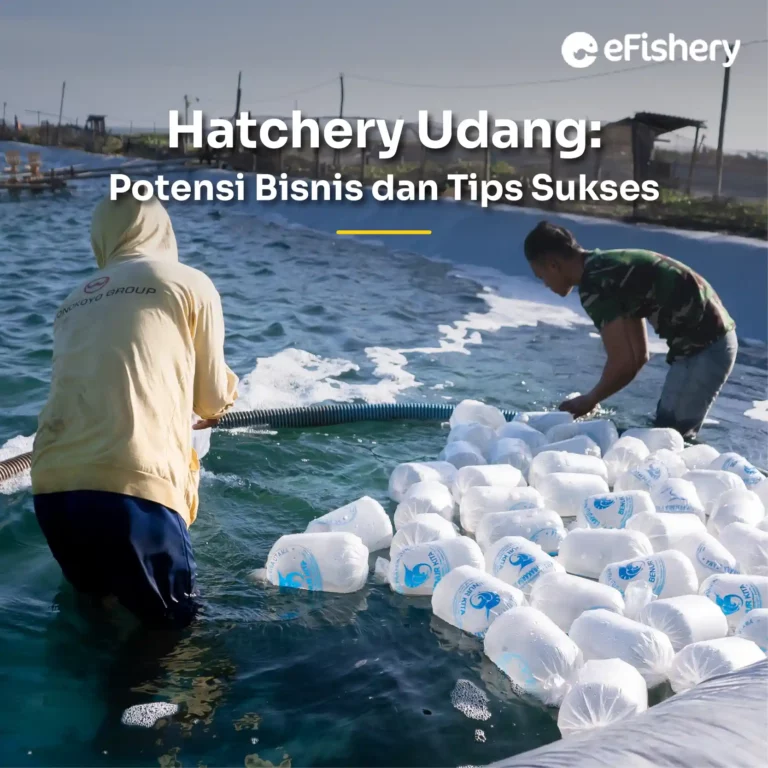Artikel Ini Telah Direview Oleh:

Sangga Sulistyo
Praktisi Aquaculture
In 2024, the government has a vision to make Indonesia the largest shrimp exporter in Indonesia. In order to achieve this vision, the quality of shrimp ponds and yields in Indonesia needs to be improved. One way to get optimal yields is with high quality fry.
In order to get these high-quality seeds, farmers are advised to start looking at the business hatchery shrimp or shrimp hatchery. If you can produce superior fry, business hatchery Shrimp is a promising business opportunity, because superior fry are highly sought after by Indonesian farmers.
It is specifically stated that the government will increase shrimp exports to 250% in 2024. This target is quite high when compared to the conditions of shrimp farming in Indonesia which have not yet been able to optimize shrimp production. In addition, outbreaks of Acute Hepatopancreatic Necrosis Disease (AHPND) which is sometimes referred to as Early Mortality Syndrome (EMS) often attack shrimp ponds in Indonesia and cause death, especially in shrimp fry in early DOC.
With these various obstacles, it is difficult for farmers to pursue targets and market opportunities that are wide open. That is why quality fry are highly sought after by farmers. There is hatchery which produces quality fry are expected to anticipate and become a solution to the outbreak of the disease.
What's that Hatchery Shrimp?
Hatchery is the process and location of the shrimp hatchery to obtain fry which will be cultivated later. On a larger scale, hatchery is a special procedure carried out to provide facilities to newly hatched eggs so as to produce superior seeds. In shrimp farming, hatchery useful for maintaining the quality of shrimp eggs before, when, and when they hatch so that they are far from the risk of exposure to viruses and diseases in aquaculture ponds.
So, before becoming shrimp fry for the rearing process in ponds, the eggs go through the hatchery process according to the procedure hatchery in order to get the best quality candidate fry.
The broodstock used to produce quality eggs and future fry are broodstock that have gone through the CPIB process or good fish/shrimp hatchery methods. Currently, Indonesia can only import the best shrimp breeders.
Caring for the broodstock also requires great care because the broodstock to be spawned will only eat fresh shrimp feed such as sea worms, squid, or marine catches.
The purpose of providing fresh live food is to maintain and guarantee the productivity of the broodstock so that the quality of the naupli (vaname shrimp at the earliest stage) is maintained. If you don't give fresh live food to the broodstock, the genes in the broodstock will be damaged and contaminated.
Business Potential Hatchery Shrimp
Before starting a shrimp farming business, you really need to understand that there are five success factors for shrimp farming, namely the location of the cultivation, the quality of the seeds or fry, the management of the culture, the quality of the feed, and the quality of the water. In other words, even though you have carefully guaranteed the water quality, culture location, and shrimp feed nutrition, your cultivation will not be optimal if the fry used are of low/low quality.
That's why hatchery Shrimp plays an important role in helping farmers get quality shrimp fry that are disease free. Some examples hatchery shrimp among them is hatchery vannamei shrimp, hatchery tiger prawns, and hatchery giant prawns.
To be able to meet the demand for business potential hatchery very tempting prawns, you need to apply the process hatchery to ensure that the fry produced are free from diseases caused by pathogens, viruses, bacteria, or other parasites. In addition, high-quality fry method results hatchery this also needs to be guaranteed to have Survival Rate (SR) is high so that the shrimp can grow healthy and not die.
Benur Certification for Hatchery Shrimp
One of the main obstacles faced by shrimp farmers is disease and epidemics. Diseases such as Acute Hepatopancreatic Necrosis Disease (AHPND) which is also often referred to as Early Mortality Syndrome (EMS) have a risk of causing death to fry. AHPND disease originates from the bacterium surnamed Vibrio or Vibriosis. Generally, this type of bacteria will be found in the post-larval period of fry and in hatchery pond water and natural feed.
Here lies the importance of certificates in procedures hatchery shrimp to distinguish shrimp from ordinary hatcheries from hatchery results from procedures hatchery high quality. Shrimp fry produced by hatcheries must be examined in a special laboratory that has been accredited by the government to determine the health conditions of the fry produced. Later, the laboratory will issue a certificate that guarantees the quality of the shrimp fry.
This certified shrimp fry will guarantee that the fry are free from pathogenic diseases (Specific Pathogen Free (SPF) or Specific Pathogen Resistant (SPR)) or other congenital diseases. Through the inspection and with the certificate, you can also find out the biological history of the fry, including the parent of the fry.
Currently, almost all of the broodstock used in Indonesia come from Hawaii or Florida, United States. There are seeds of results hatchery who don't have broods but buy naupli from hatchery others have a parent. This condition is valid as long as the parent source is guaranteed.
Business Tips Hatchery Shrimp
So that the hatchery business hatchery successful shrimp, there are a number of things that need to be considered by you, such as the quality of the fry feed and the quality of the pond water.
1. Type of Shrimp Feed
Considering that shrimp fry have a small body size, the size of the feed given must also match the size of the mouth. The following are options for shrimp fry feed that you can choose during the hatchery process, including:
- Artemia, natural food derived from animals, or zooplankton. The method of administration is to incubate artemia in a special container first.
- Natural food for the type of phytoplankton or plant-based, namely algae.
- Artificial feed in the form of powder with a size of 50-350 microns.
2. Pool Water Quality
In addition to feed, you must also maintain the quality of pond water by carrying out routine checks so as to create a controlled and conducive environment or media for the growth of the shrimp larvae. The trick is to check the oxygen level and pH of the water regularly.
The dissolved oxygen level in the shrimp fry hatchery must be > 5 ppm. You can use a DO meter to measure the oxygen level. Meanwhile, to find out the pH level of the water, you can use an accurate pH meter to determine whether the pH level of the pool water is at the optimal level, which is 7-8.3.
Get Tips for Successful Shrimp Cultivation at eFarm
Need Help Regarding Shrimp Cultivation Business?
Fill in your personal data in the following form. Our team will immediately contact you via the number cellphone attached. Make sure the data entered is correct.
Using yield fry hatchery Shrimp is indeed quite important to produce superior quality shrimp. However, you need to remember that there are 4 other aspects that also affect the success of shrimp farming, such as determining the right cultivation location, culture management, feed quality, and water parameters. All of these aspects must be mastered to maximize shrimp yields.
There is an easy way to get tips and tricks for cultivating shrimp directly from the experts, namely by eFarm!
eFarm is an app for Shrimp Farmers that provides various solutions to shrimp farming problems. Through eFarm, Mr/Mrs can learn and get information about shrimp farming from trusted experts and senior cultivation practitioners. You can also get high-quality shrimp farming supporting products at the best prices at Cultivation Shop.
If you want to consult directly with an Aquaculture Expert, there is a feature Cultivation Consultation which can be used 24 hours a day. The opportunity to produce the best quality shrimp harvest is wide open!

Sangga Sulistyo - Praktisi Aquaculture
Sangga adalah praktisi Aquaculture yang memulai karirnya pada tahun 2003 dan sekarang menjadi Technical Support Manager eFishery untuk seluruh wilayah Indonesia
Questions Regarding the Potential of Shrimp Hatchery Business
In brief, hatchery is the process and location of the shrimp hatchery to obtain fry which will be cultivated later. On a larger scale, hatchery is a special procedure carried out to provide facilities for newly hatched shrimp eggs so as to produce superior seeds.
This certified shrimp fry will guarantee that the fry are free from pathogenic diseases (Specific Pathogen Free (SPF) or Specific Pathogen Resistant (SPR)) or other congenital diseases. Through the inspection and with the certificate, you can also find out the biological history of the fry, including the parent of the fry.
- https://www.minapoli.com/info/prospek-cerah-industri-hatchery-udang
- https://www.isw.co.id/post/2020/01/20/alat-dan-bahan-untuk-proses-hatchery-udang-vaname
- https://finance.detik.com/berita-ekonomi-bisnis/d-5537275/budidaya-udang-jadi-peluang-bisnis-menjanjikan-tapi-ini-kendalanya
